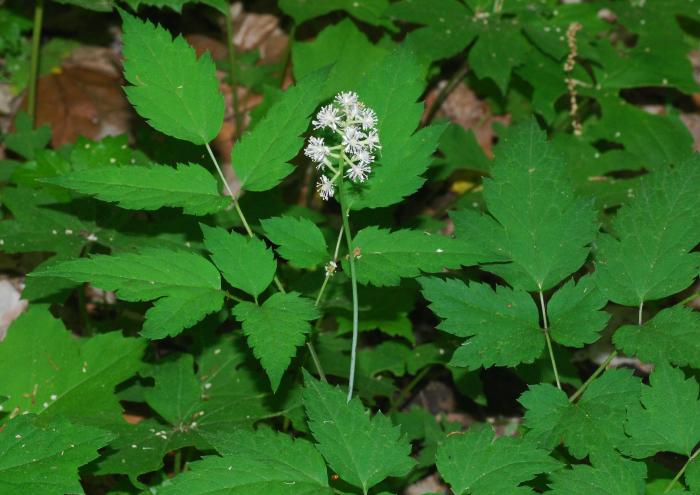Actaea pachypoda Elliott
Doll's Eyes

Native
CC = 8
CW = 3
MOC = 45
© SRTurner
Actaea pachypoda ElliottDoll's Eyes | |
 |
Native CC = 8 CW = 3 MOC = 45 |
© SRTurner |
|
Family - Ranunculaceae Habit - Rhizomatous perennial forb, sometimes with a somewhat woody base. Stems - To +50cm tall, glabrous, from thick large rhizome, herbaceous, purplish at base.
Leaves - Alternate, twice ternately divided, glabrous, petiolate. Ultimate divisions serrate, with shallow lobes. Total leaf length(with petiole) +40cm long, +30cm broad.
Inflorescence - Axillary pedunculate raceme with +/-15 flowers, to 10cm long(tall). Peduncle to +15cm, glabrous. Pedicels thick, 1cm long, 1.5mm in diameter, thickened at apex, with antrorse pubescence. Small acuminate bract subtending each pedicel. Peduncle and pedicels enlarging and becoming red in fruit.
Flowers - Petaloid sepals 4-5, white, truncate to 3-notched at apex, 5mm long, 1.5mm broad. Stamens +20. Filaments to 6-7mm long, white, glabrous, slightly expanded(thickened) just below anthers. Anthers pale yellow, .6mm in diameter. Ovary superior, white, glabrous, 3mm long, 2mm broad, urceolate. Placentation parietal. Stigma capitate, 2-lobed.
Fruit - A white subglobose berry with +/-5 seeds. Berry with black dot at apex, to 1cm long, with vertical groove.
Fruits - Berries, 1 per flower stalk, 5-10 mm long, ellipsoid or spherical, white. Flowering - May - June. Habitat - Ravines, rich thick woods, north facing slopes, base of bluffs. Origin - Native to U.S. Other info. - This is a plant which is equally attractive in flower and in fruit. The species name means "thick foot" and one look at the big rhizome of the plant shows that it is aptly named. The rhizome used to be used, and probably still is, to treat pain and bronchial troubles. However, the plant is generally considered toxic, and some people get violent gastric distress from ingesting it. Contact can also cause skin blisters and irritation. Photographs taken at the Jamerson C. McCormack Conservation Area, Holt County, MO., 5-3-00, and in the red hills of Alabama, 3-25-06 (DETenaglia); also at Faust County Park, St. Louis County, MO, 5-7-2014; and LaBarque Creek Conservation Area, Jefferson County, MO, 8-27-2018 (SRTurner). |